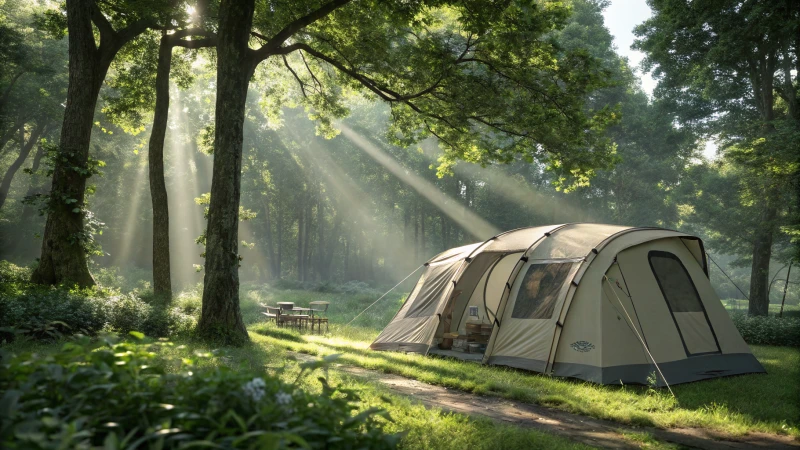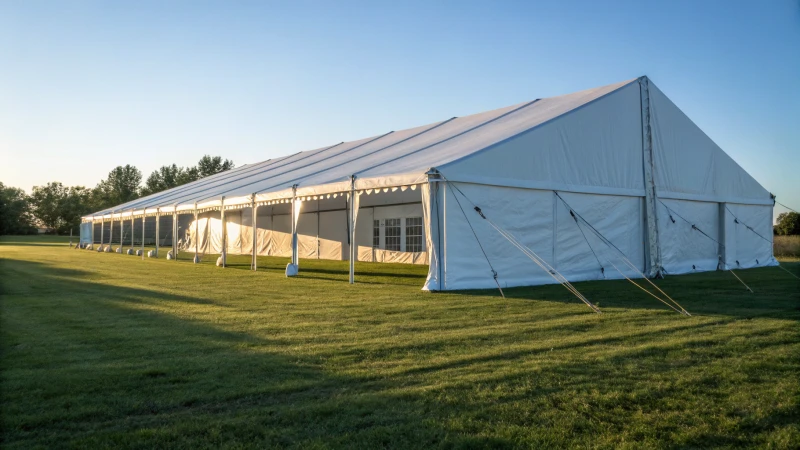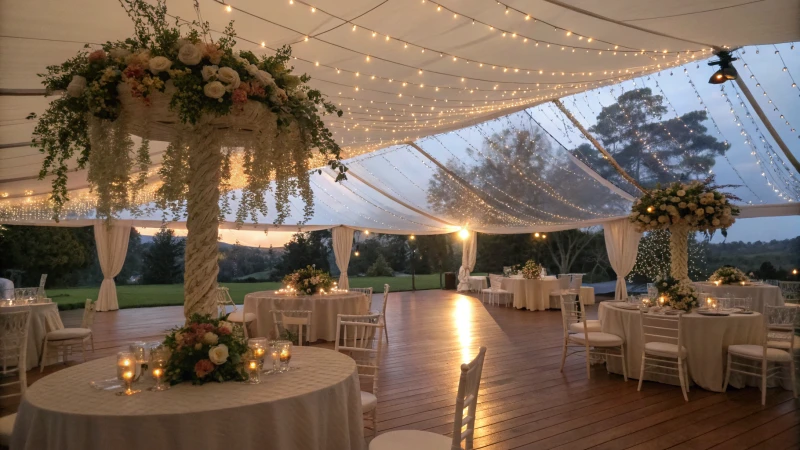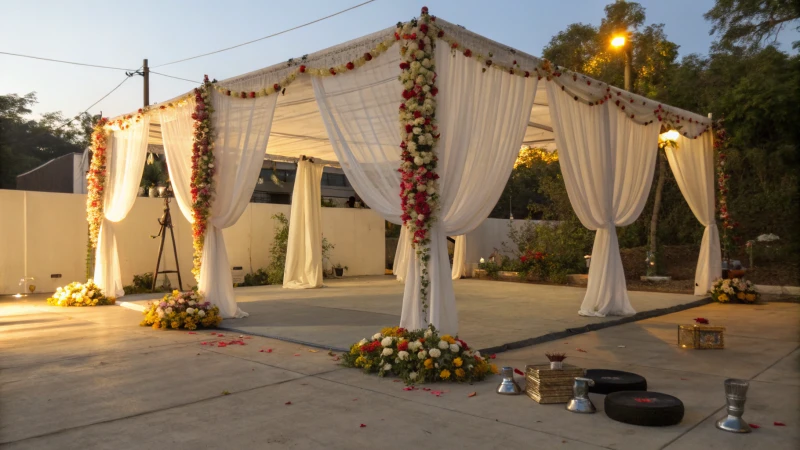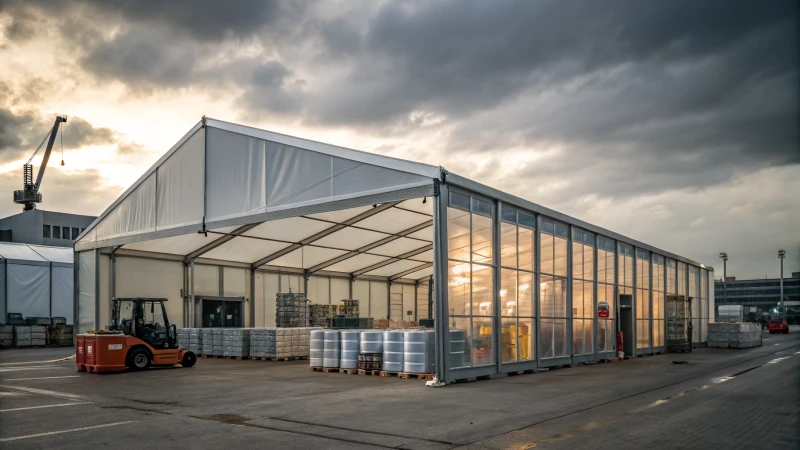
Have you ever considered using a tent as your warehouse? It might sound unconventional, but it offers flexibility that traditional buildings just can’t match.
Using a tent as a warehouse is indeed a viable option for those needing flexible and cost-effective storage solutions. These tents are designed to be modular, allowing for quick installation and adaptability to different environments, making them ideal for businesses with changing inventory needs.
Let me take you back to the time when I faced a massive influx of inventory that my existing space just couldn’t handle. That’s when I stumbled upon the idea of using a tent as a warehouse. It was a game-changer. Not only did it provide the additional space I desperately needed, but it also allowed me to easily adjust the layout as our needs evolved.
These tents come with various customization options and can stand up to different weather conditions, which was crucial for my peace of mind. It’s not just about the practicality; there’s an environmental angle too. With minimal waste and adherence to green building standards, these warehouse tents offer a sustainable solution that aligns with modern business ethics.
Aluminum tents are cheaper than traditional warehouses.True
Aluminum tents offer cost savings through modular designs and rapid installation.
Warehouse tents cannot be customized for different industries.False
Warehouse tents are highly adaptable, allowing customization for various industry needs.
Why Consider Using Warehouse Tents?
Ever wondered how to keep up with shifting storage needs without breaking the bank? Warehouse tents might just be your game-changer.
Warehouse tents are a flexible and cost-effective solution for varying storage needs. They offer quick setup, adaptability, and customization options, making them an efficient alternative to traditional warehouses. These tents ensure effective space utilization while being environmentally friendly and versatile in application.
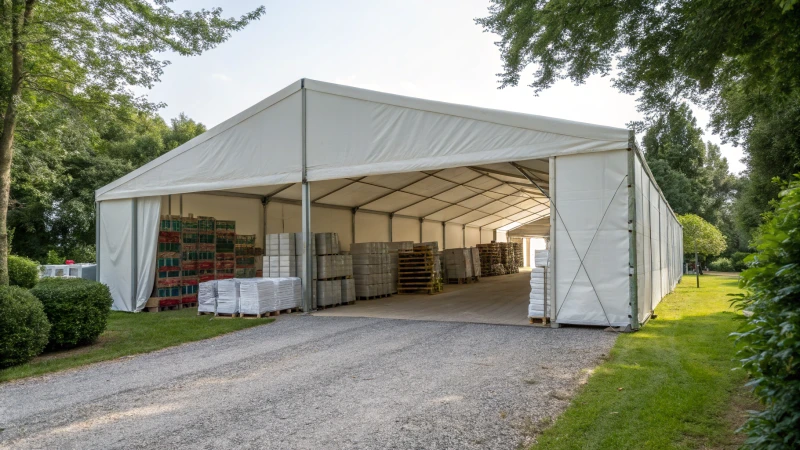
I remember a time when I faced a surge in inventory that our traditional warehouse simply couldn’t handle. It was a logistical nightmare until I discovered the world of warehouse tents. These structures revolutionized our approach, offering flexibility and speed I never thought possible.
Flexibility and Adaptability
Warehouse tents are like the Swiss Army knives of storage solutions. You can easily adjust their dimensions or even add climate controls to meet specific needs. Unlike the rigid confines of traditional warehouses, these tents allow for expansion or reduction as needed. I found this particularly useful during peak seasons when inventory levels soared, enabling us to respond swiftly to changes in storage requirements1.
Cost-Effectiveness
The initial costs of setting up a warehouse tent are much lower than building a traditional warehouse. Plus, maintenance doesn’t break the bank either. I remember saving so much on labor and installation time that it felt like a victory for my budget. This approach is perfect for businesses needing temporary storage without committing to permanent structures.
| Feature | Warehouse Tents | Traditional Warehouses |
|---|---|---|
| Cost | Lower initial and upkeep | Higher initial and upkeep |
| Installation Time | Quick setup | Lengthy construction |
| Flexibility | Easily customizable | Rigid structure |
Environmental Considerations
I’m increasingly conscious of our environmental impact, and warehouse tents tick that box too. Made from sustainable materials like aluminum frames and PVC fabrics, they minimize waste and can be recycled. Plus, modular designs allow for energy-efficient setups, which aligns perfectly with my green business goals by optimizing natural lighting and reducing energy consumption.
Versatile Applications
Beyond just storage, these tents serve a myriad of purposes. Whether it’s logistics or hosting events, the adaptability is incredible. With options for heating and cooling, I’ve used them to maintain optimal conditions for sensitive products across various climates with enhanced functional efficiency2.
Quick Installation and Removal
The speed at which you can set these up is astonishing—days rather than months. This was crucial when I needed to respond to sudden market changes or emergencies. Their modular nature also means they can be set up on virtually any terrain without extensive groundwork preparation, saving us countless hours in groundwork preparation.
Customization for Specific Needs
The ability to tailor these tents to my specific operational needs was a game-changer. Whether it was advanced climate control systems or transparent materials for better lighting, the level of personalization available made them a superior choice over fixed buildings.
Companies can also select from various door systems to ensure optimized workflow3 and secure storage conditions.
In conclusion, while the benefits are clear, it’s essential to assess your unique requirements when considering warehouse tents as a solution. Their adaptability and cost-effectiveness make them an attractive option for those looking to enhance storage capabilities efficiently without compromising on quality or flexibility.
Warehouse tents are more environmentally friendly.True
They use sustainable materials like aluminum and PVC, reducing waste.
Traditional warehouses have quicker installation times.False
Warehouse tents can be set up in days, unlike lengthy warehouse construction.
How Do Warehouse Tents Compare to Traditional Warehouses?
Remember the last time you scrambled for extra storage at the drop of a hat? That’s where warehouse tents come in, offering a flexible and cost-effective solution.
Warehouse tents excel in flexibility, cost-efficiency, and adaptability compared to traditional warehouses. They are easily customizable, quick to set up, and adaptable to various environments, making them ideal for businesses with dynamic storage needs.
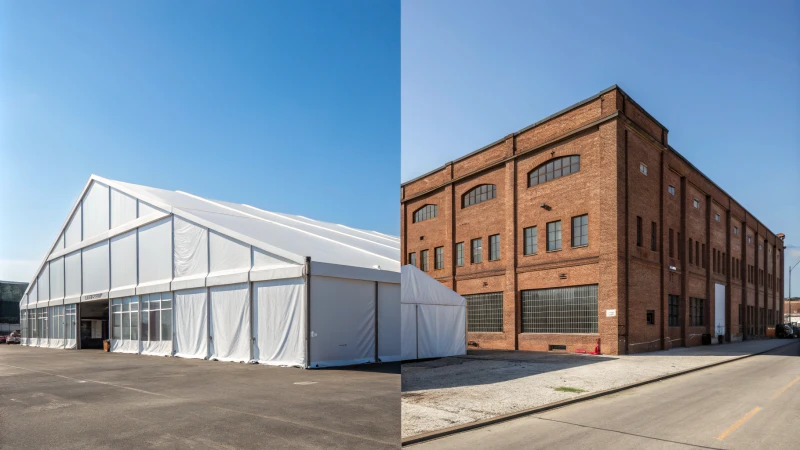
Flexibility and Customization
Let me tell you about the time I had to quickly find a storage solution that could handle my constantly changing inventory. That’s when I discovered warehouse tents. They offer unmatched flexibility when it comes to customization4. I could adjust the width, length, and height to fit my specific needs. This was a game-changer compared to traditional warehouses with their rigid dimensions. Imagine having the freedom to expand or downsize swiftly, just like moving around puzzle pieces, depending on inventory levels. It was exactly what I needed for my business’s fluctuating demands.
Cost Considerations
Budgeting is always on my mind, especially when setting up new projects. I found warehouse tents to be a more economical choice compared to traditional warehouses. The initial investment was lower because I didn’t have to worry about permanent construction costs. Plus, their modular nature meant I only paid for the space I actually used, avoiding unnecessary expenses of maintaining underutilized areas common with conventional warehousing5.
Installation Time and Adaptability
Time is money, as they say, and I quickly learned how true that is when setting up a new storage facility. With warehouse tents, I was able to have everything up and running in just a few days, whereas traditional warehouses could take months or even years. This rapid setup was crucial when I needed immediate storage solutions. Another perk? These tents can be installed on various surfaces, including uneven terrains, which made them incredibly adaptable to different locations.
| Aspect | Warehouse Tents | Traditional Warehouses |
|---|---|---|
| Installation Time | Days | Months/Years |
| Cost | Lower Initial Investment | Higher Initial Investment |
| Flexibility | Highly Customizable | Fixed Dimensions |
| Adaptability | Works on Various Terrains | Requires Level Ground |
| Environmental Impact | Eco-friendly, less waste | Potential higher environmental impact |
Environmental Impact
In today’s world, sustainability is more than just a buzzword; it’s a necessity. Many warehouse tents are designed with eco-friendliness in mind, utilizing materials and construction methods that minimize waste and reduce pollution. This resonated with my values and the growing environmental concerns of our time. In contrast, traditional warehouses often involve more material usage and waste during construction.
Climate Control and Insulation
I remember being skeptical about how well a tent could handle climate control until I experienced it firsthand. With advancements in materials, these warehouse tents have excellent insulation properties. They can maintain stable indoor temperatures using special fabrics and integrated climate control systems. While traditional warehouses offer robust climate control but usually at a higher operational cost due to their larger size and fixed infrastructure6. But for me, the balance of cost-efficiency and effective climate control made warehouse tents the superior choice.
Warehouse tents have lower initial costs than traditional warehouses.True
Warehouse tents require less initial investment as they don't need permanent construction.
Traditional warehouses are more adaptable to uneven terrains.False
Traditional warehouses need level ground, while tents can adapt to uneven surfaces.
Can Warehouse Tents Withstand Harsh Weather Conditions?
Picture this: a storm is rolling in and you need to ensure your storage remains safe and secure. Can a warehouse tent really stand up to such harsh weather?
Yes, warehouse tents can withstand harsh weather conditions. Crafted from durable materials like high-grade aluminum frames and PVC-coated fabrics, these tents are built to endure extreme conditions. They’re designed for weather resistance and anchored securely to various surfaces, ensuring reliability even in heavy rain, snow, or wind.
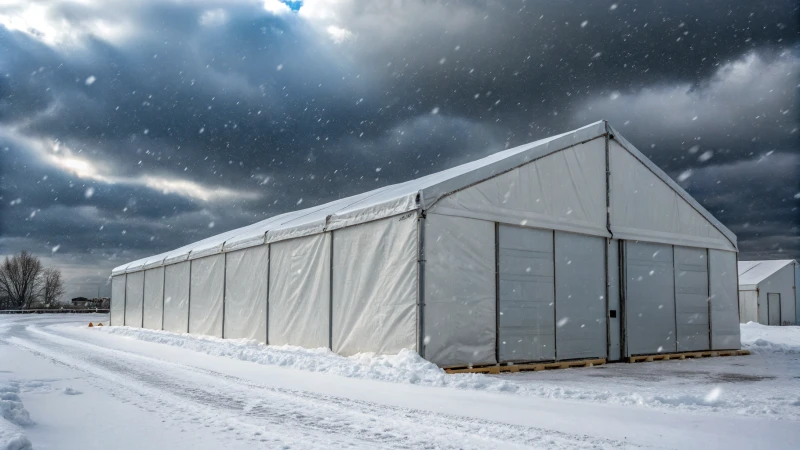
Material Strength and Durability
I remember the first time I had to consider whether a warehouse tent could hold up against the elements. I was in charge of a large outdoor event, and the forecast predicted a storm. The tents we used were made from high-grade aluminum frames—strong yet flexible enough to handle the gusty winds we were expecting. Paired with PVC-coated synthetic fabrics, these tents provided the kind of waterproof and UV-resistant protection that left me feeling reassured, knowing they could withstand both rain and sun.
| Material | Property |
|---|---|
| Aluminum Frame | Strong, lightweight, corrosion-resistant |
| PVC Fabric | Waterproof, UV-resistant, durable |
Anchoring Methods
One key lesson I’ve learned is that proper anchoring makes all the difference. Whether it’s stakes for grass or weights for concrete, ensuring your tent is securely fastened is crucial. In my experience, these methods have kept tents stable even when the wind starts howling.
Climate-Specific Designs
One winter, I needed to set up a tent in a region notorious for its biting cold. The manufacturer suggested a cold-weather tent7 with insulated walls and heating systems, which kept the indoor temperature stable despite the icy conditions outside. That experience taught me the value of climate-specific designs.
Real-World Applications
I’ve seen businesses in storm-prone areas rely on warehouse tents not just for their adaptability but for their tested durability. Companies like Qiangyu8 offer customized solutions that have been put through rigorous tests to ensure they stand up to whatever Mother Nature throws their way.
It’s clear that with the right materials and design considerations, warehouse tents are more than capable of handling harsh weather conditions. Their versatility and durability make them a reliable choice for businesses facing tough environmental challenges.
Aluminum frames are corrosion-resistant.True
Aluminum is known for its natural resistance to corrosion, making it ideal for outdoor structures.
PVC fabrics used in tents are not UV-resistant.False
PVC-coated fabrics are UV-resistant, protecting against sun damage and prolonging lifespan.
Are Warehouse Tents Environmentally Friendly?
Imagine standing in a field, surrounded by a massive, gleaming structure that seems to float effortlessly. Could this be the future of sustainable storage?
Warehouse tents are indeed eco-friendly due to their minimal material use, modular nature, and reduced waste. They can be easily relocated and reused, lowering the carbon footprint and supporting sustainability.
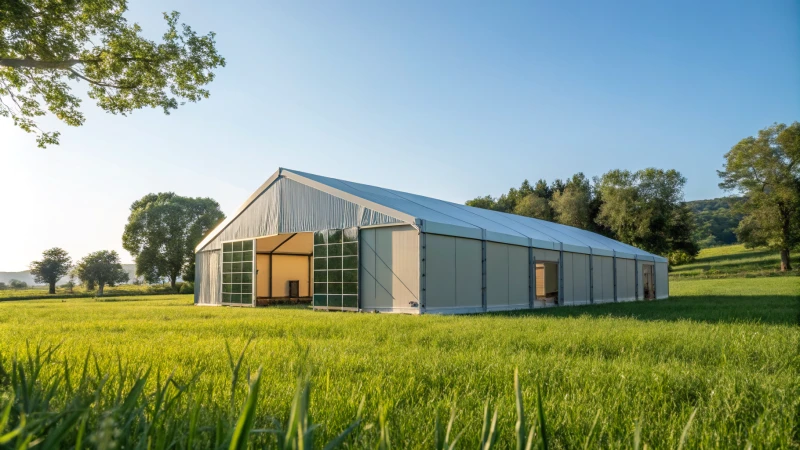
Material Efficiency and Waste Reduction
I remember the first time I saw a warehouse tent up close. It was at a trade show, and I was struck by how the lightweight aluminum alloy9 frame and PVC-coated fabric seemed so sturdy yet used so little material compared to the usual concrete giants. These tents don’t just look sleek; they save on resources and energy during production. Plus, their modular design means they can be taken down and set up elsewhere, cutting down on construction waste.
Energy Consumption and Carbon Footprint
Setting up a warehouse tent10 is like watching magic unfold—it’s done in a fraction of the time needed for a permanent warehouse. This speedy installation means less energy is spent, translating to a lower carbon footprint. I once saw a team install a tent on uneven terrain without disturbing the ground much—no bulldozers, no chaos. And with options for transparent or semi-translucent fabrics, you can use natural light to keep energy consumption in check.
| Environmental Feature | Traditional Warehouse | Warehouse Tent |
|---|---|---|
| Construction Time | High | Low |
| Material Usage | Extensive | Minimal |
| Carbon Footprint | High | Low |
| Waste Generation | High | Low |
Adaptability and Reusability
I was chatting with a business owner who had to expand her storage quickly. She opted for a warehouse tent because it could be resized and moved easily. This adaptability is a game-changer—no demolishing or starting from scratch. It supports a circular economy by extending the life of materials used, letting businesses expand or downsize without environmental guilt.
For instance, companies can easily expand or downsize11 their storage space without the environmental cost of demolishing or constructing new buildings.
Compliance with Green Building Standards
Manufacturers are increasingly aligning their warehouse tents with green building standards. I visited one such company where recyclable materials were the norm, and energy efficiency wasn’t just a feature; it was a promise. By choosing these eco-conscious tents, businesses contribute to sustainability goals while keeping their carbon footprint in check.
In essence, warehouse tents aren’t just about meeting storage needs; they’re about doing it responsibly. With efficient material use, lower energy demands, and reusability, they offer a greener alternative for businesses aiming to reduce their environmental impact. Learn more about green building12.
Warehouse tents use less energy for installation.True
Warehouse tents require less energy and time to install, lowering carbon footprint.
Warehouse tents cannot be reused or relocated.False
Warehouse tents can be resized, relocated, or reconfigured, enhancing adaptability.
Conclusion
Warehouse tents offer a flexible, cost-effective storage solution, easily customizable and quick to install, making them ideal for businesses with fluctuating inventory needs while being environmentally friendly.
-
Discover how warehouse tents can be easily expanded or downsized according to fluctuating inventory levels. ↩
-
Learn about the variety of door systems available for improved accessibility and security. ↩
-
Find out how businesses can tailor warehouse tents with specific features like climate control and lighting. ↩
-
Explore various customization options available for warehouse tents. ↩
-
Compare the cost differences between warehouse tents and traditional warehouses. ↩
-
Learn how climate control differs between warehouse tents and traditional warehouses. ↩
-
Discover how specialized tents are built to endure freezing temperatures with insulation and heating features. ↩
-
Learn about Qiangyu’s bespoke tent solutions designed to withstand severe weather through customization. ↩
-
Discover how aluminum alloy contributes to sustainable building practices in warehouse tents. ↩
-
Explore how the installation of warehouse tents impacts energy use and carbon footprint. ↩
-
Learn about the adaptability of warehouse tents and how resizing benefits sustainability. ↩
-
Understand how warehouse tents meet green building standards and contribute to sustainability. ↩




